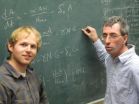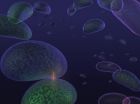(Press-News.org) Energy efficiency experts at the University of East Anglia (UEA) are calling for ambitious new targets to reduce energy demand across the European Union.
In a report published today by the Build with CaRe consortium, the researchers propose a new EU target of a 40 per cent reduction in primary energy demand by 2050. The existing target is a 20 per cent improvement in energy efficiency by 2020, but the EU is currently on track to achieve only half of this.
The report by Dr Bruce Tofield and Martin Ingham, associate consultants at UEA's Adapt Low Carbon Group concludes that radically improving the energy efficiency of new and existing buildings is key to reducing global greenhouse gas emissions, and Europe should be leading the way.
A 40 per cent reduction by 2050 for the EU is in line with the ambitions of new Energy and Climate Change Secretary Ed Davey. At the launch of his new Energy Efficiency Deployment Office earlier this month, he called for a cut in UK energy use of between a third and a half by 2050.
"Buildings are responsible for 40 per cent of Europe's energy-related greenhouse gas emissions, so overhauling their energy efficiency represents the greatest opportunity for energy saving and greenhouse gas reduction," said Dr Tofield.
"By making its building stock energy efficient, the EU can demonstrate that economic growth is consistent with reduced energy demand and lead the transition to a sustainable world. A long-term target of 40 per cent would galvanise the near-term action on energy efficiency that is essential if action to tackle potentially dangerous climate change is to succeed."
The consensus among climate scientists is that global warming above 2 degrees can only be avoided if global greenhouse emissions begin to reduce before 2020. However, current projections show fossil fuel use and greenhouse gas emissions continuing to increase for decades.
Dr Tofield said he agreed with the EU Commission's Energy Roadmap 2050 that a big reduction in energy demand is achievable and that very energy efficient buildings should become the norm, but he said many barriers remained.
"The biggest barrier is lack of political will to accelerate progress in energy efficiency," he said.
"New build ambition is insufficient and the rate of building refurbishment to achieve high standards of energy efficiency is far too low. Political will to transform buildings will demonstrate EU leadership on climate action post-Durban. Cities across the EU can lead this change."
Build with CaRe is a consortium of local authorities and universities from five countries across the North Sea region, funded partly by the European Regional Development Fund. Its aim is to make energy-efficient building design the mainstream. A key strategy is the promotion of the innovative 'passivhaus' concept which can reduce energy use for heating and cooling buildings by 90 per cent. Adopting passivhaus quality as the building industry standard for both new build and refurbishment of existing buildings will also bring financial and well-being benefits for occupants.
John Helmfridsson, a passive house expert at Passivhuscentrum in Västra Götaland, Sweden, and a Build with CaRe partner, agreed: "Energy efficiency is becoming a main competitive advantage to countries and companies investing in the issue. To not use or further develop knowledge would be hazardous, not only to the environment but to the European economy."
INFORMATION:
'Refurbishing Europe: An EU strategy for energy efficiency and climate action led by building refurbishment' by Bruce Tofield and Martin Ingham is published on Monday February 27. For more information or to download the report, visit www.buildwithcare.eu or www.lcic.com
END
Researchers have identified an elusive gene responsible for Thrombocytopenia with Absent Radii (TAR), a rare inherited blood and skeletal disorder. As a result, this research is now being transformed into a medical test that allows prenatal diagnosis and genetic counselling in affected families.
The team used genetic sequencing to discover that TAR results from low levels of the protein called Y14. They found that the syndrome occurs by a unique inherited mechanism.
Platelets are the second most abundant cell in the blood. Their main task is to survey the blood vessel ...
Ancient manuscripts written by Arabic scholars can provide valuable meteorological information to help modern scientists reconstruct the climate of the past, a new study has revealed. The research, published in Weather, analyses the writings of scholars, historians and diarists in Iraq during the Islamic Golden Age between 816-1009 AD for evidence of abnormal weather patterns.
Reconstructing climates from the past provides historical comparison to modern weather events and valuable context for climate change. In the natural world trees, ice cores and coral provide evidence ...
Japanese scientists have found that the odorous compound responsible for halitosis – otherwise known as bad breath – is ideal for harvesting stem cells taken from human dental pulp.
In a study published today, Monday 27 February, in IOP Publishing's Journal of Breath Research, researchers showed that hydrogen sulphide (H2S) increased the ability of adult stem cells to differentiate into hepatic (liver) cells, furthering their reputation as a reliable source for future liver-cell therapy.
This is the first time that liver cells have been produced from human dental ...
Washington, D.C.— Seawater circulation pumps hydrogen and boron into the oceanic plates that make up the seafloor, and some of this seawater remains trapped as the plates descend into the mantle at areas called subduction zones. By analyzing samples of submarine volcanic glass near one of these areas, scientists found unexpected changes in isotopes of hydrogen and boron from the deep mantle. They expected to see the isotope "fingerprint" of seawater. But in volcanoes from the Manus Basin they also discovered evidence of seawater distilled long ago from a more ancient plate ...
STANFORD, Calif. — Humans aren't the only species that like to get busy with a glass of bubbly, according to researchers at the Stanford University School of Medicine. Turns out, the common baker's yeast has indulged in a frenzy of amorous frolicking in the fermentation vats of winemakers for hundreds, possibly thousands, of years, with interesting results.
The unexpected promiscuity has made the lineage of many commercial and wild yeast strains difficult to trace. But there are also indications that such willy-nilly sharing of genetic information is precisely what gives ...
MAYWOOD, Ill. – In a study published in Nature Medicine, Loyola researchers report on a promising new technique that potentially could turn immune system killer T cells into more effective weapons against infections and possibly cancer.
The technique involves delivering DNA into the immune system's instructor cells. The DNA directs these cells to overproduce a specific protein that jumpstarts important killer T cells. These killer cells are typically repressed in patients who have HIV or cancer, said José A. Guevara-Patino, MD, PhD, senior author of the study. Guevara ...
Most people attempt to reduce the little uncertainties of life by carrying umbrellas on cloudy days, purchasing automobile insurance or hiring inspectors to evaluate homes they might consider purchasing. For scientists, reducing uncertainty is a no less important goal, though in the weird realm of quantum physics, the term has a more specific meaning.
For scientists working in quantum physics, the Heisenberg Uncertainty Principle says that measurements of properties such as the momentum of an object and its exact position cannot be simultaneously specified with arbitrary ...
SALT LAKE CITY, Feb. 27, 2012 – University of Utah mathematicians developed a set of calculus equations to make it easier for doctors to save Tylenol overdose patients by quickly estimating how much painkiller they took, when they consumed it and whether they will require a liver transplant to survive.
"It's an opportunity to use mathematical methods to improve medical practice and save lives," says Fred Adler, a professor of mathematics and biology and coauthor of a study that developed and tested the new method.
The study of acetaminophen – the generic pain and ...
For the past decade, scientists have been pursuing cancer treatments based on RNA interference — a phenomenon that offers a way to shut off malfunctioning genes with short snippets of RNA. However, one huge challenge remains: finding a way to efficiently deliver the RNA.
Most of the time, short interfering RNA (siRNA) — the type used for RNA interference — is quickly broken down inside the body by enzymes that defend against infection by RNA viruses.
"It's been a real struggle to try to design a delivery system that allows us to administer siRNA, especially if you ...
PASADENA, Calif.—Bacteria have evolved different systems for secreting proteins into the fluid around them or into other cells. Some, for example, have syringe-like exterior structures that can pierce other cells and inject proteins. Another system, called a type VI secretion system, is found in about a quarter of all bacteria with two membranes. Despite being common, researchers have not understood how it works. Now a team, co-led by researchers at the California Institute of Technology (Caltech), has figured out the structure of the type VI secretion system apparatus ...

